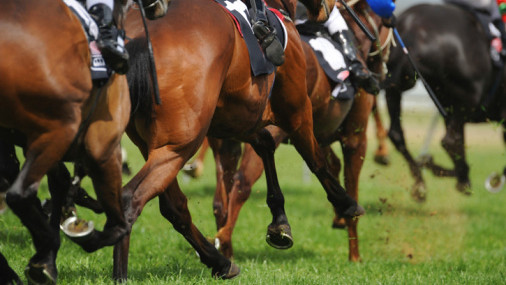Analysis and prevention of spinal injuries in horse racing
This research aims to analyse the mechanisms of equestrian injury, and to identify viable routes for the design of interventions to minimise injury occurrence.

There are an estimated 1.3 million people in the UK who regularly ride horses, and despite riding being a healthy activity that people of all ages can enjoy, it carries a high risk of injury. One area that requires better understanding is significant spinal injuries, which are rare but have a life-changing impact. In the last 30 years patterns of injuries in professional and amateur riders have been studied using pictures or video footage. However, little is known about the mechanisms related to spinal injuries in riding and this limits the ability to improve safety.
To understand the complexity of how spinal injuries occur, the research team for this project will combine information from a variety of sources to create computer simulations. Once a computer simulation is done, they will look at what happens in terms of injury outcome if they change a variable such as the way someone falls, anatomical spine features, and whether they are wearing protective equipment.
To create the computer simulation model, the research team will collect information about injuries that occur and look at this alongside video footage of the incident. They'll carry out experiments where professional riders are filmed during “falls training” on a simulator to ensure the validity and applicability of the computer model.
Researchers will start by collecting this information in horse racing, as they know that they can access the information needed in this setting. Once they have developed a valid and reliable model in this setting they will be able to apply this to other riding disciplines. This programme of work is a key step and will help all stakeholders in riding to develop injury prevention approaches to reduce the number of serious injuries that occur, making an activity that so many people enjoy safer.
Research team
- Dr Dario Cazzola, Lecturer in the Department for Health (Principal Investigator)
- Dr Keith Stokes, Professor in the Department for Health (Co-Investigator)
- Dr Polly McGuigan (Co-Investigator)
- Dr Jerry Hill, Chief Medical Advisor of the British Horseracing Authority
Project objectives
- To categorise and quantitatively describe injuries from the analysis of video footage
- To analyse the effect of protective garments on trunk and head movement during a simulated fall
- To accurately measure and analyse the biomechanical load and body motion during simulated falls
- To identify the injury mechanisms related to different injurious events via musculoskeletal models and computer simulations
- To devise the application of the injury analysis framework on other riding disciplines
Expected outcomes
- Identification and high-level description of the environmental, behavioural, and biomechanical features related to equestrian spinal injuries
- Accurate measurement of whole body, trunk, and head motion and biomechanical load during staged falls, as well as quantitative analysis on the effect of protective garments on spinal injury risk
- Estimation of the internal load experienced by jockeys and identification of the safest falling technique used
- An optimised version of the simulation and analysis framework to investigate the injury mechanisms from a selected database of non-racing events
Funding
This project is funded by The Racing Foundation.
Funded PhD studentship
We're accepting applications for a 3 year full time funded PhD studentship to work as part of this research team.
